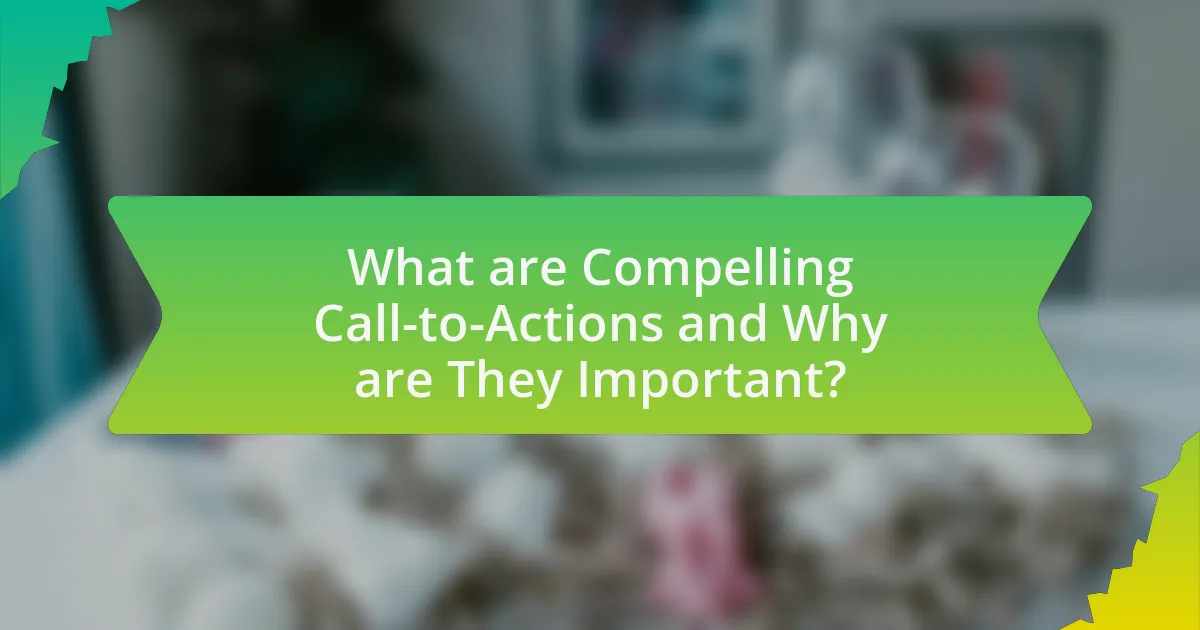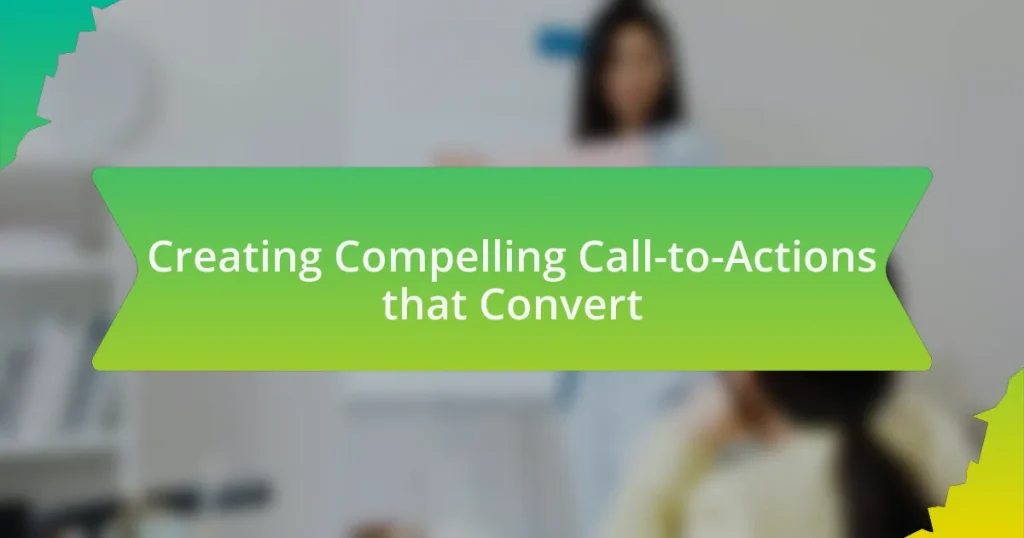Compelling Call-to-Actions (CTAs) are essential marketing tools designed to prompt users to take specific actions, such as signing up for newsletters or making purchases. This article explores the significance of CTAs in enhancing conversion rates, highlighting how effective wording, design, and psychological triggers like urgency and scarcity can influence user behavior. It also examines the different types of CTAs, the importance of personalization, and common pitfalls to avoid. Additionally, best practices for crafting effective CTAs and methods for testing and optimizing their performance are discussed, providing a comprehensive guide for marketers aiming to improve engagement and drive sales.

What are Compelling Call-to-Actions and Why are They Important?
Compelling call-to-actions (CTAs) are specific prompts designed to encourage users to take a desired action, such as signing up for a newsletter or making a purchase. They are important because they guide users through the conversion funnel, increasing engagement and driving sales. Research indicates that effective CTAs can boost conversion rates by up to 200%, demonstrating their critical role in marketing strategies.
How do Compelling Call-to-Actions influence conversion rates?
Compelling Call-to-Actions (CTAs) significantly enhance conversion rates by directing user behavior towards specific actions. Research indicates that effective CTAs can increase conversion rates by up to 202% when they are clear, actionable, and visually distinct. For instance, a study by HubSpot found that personalized CTAs outperform generic ones by 202%, demonstrating the importance of tailoring messages to the audience. Additionally, CTAs that create a sense of urgency, such as “Limited Time Offer,” can further motivate users to act quickly, thereby increasing the likelihood of conversion.
What psychological triggers do effective Call-to-Actions utilize?
Effective Call-to-Actions (CTAs) utilize psychological triggers such as urgency, scarcity, social proof, and reciprocity. Urgency prompts immediate action by creating a fear of missing out, as seen in time-limited offers that encourage quick decisions. Scarcity enhances the perceived value of an offer by indicating limited availability, which can lead to increased demand; for example, phrases like “only a few left” can drive conversions. Social proof leverages the influence of others, as testimonials or user counts can validate a choice, making potential customers more likely to engage. Reciprocity involves offering something of value upfront, which can create a sense of obligation to respond positively, such as free trials or valuable content. These triggers are supported by research indicating that urgency can increase conversion rates by up to 332% (source: “The Psychology of Urgency,” ConversionXL, Peep Laja).
How do Call-to-Actions fit into the overall marketing strategy?
Call-to-Actions (CTAs) are integral components of an overall marketing strategy as they guide potential customers toward desired actions, such as making a purchase or signing up for a newsletter. By clearly directing user behavior, CTAs enhance conversion rates, which are critical for measuring the effectiveness of marketing efforts. For instance, a study by HubSpot found that personalized CTAs can increase conversion rates by 202%, demonstrating their significant impact on marketing success. Thus, effective CTAs not only drive immediate actions but also align with broader marketing goals by optimizing customer engagement and improving return on investment.
What elements make a Call-to-Action compelling?
A compelling Call-to-Action (CTA) includes clarity, urgency, and value proposition. Clarity ensures that the audience understands what action to take, such as “Sign Up Now” or “Get Your Free Trial.” Urgency creates a sense of immediacy, often through phrases like “Limited Time Offer” or “Act Fast.” The value proposition highlights the benefits of taking action, making it clear what the user will gain, such as “Join 10,000 Happy Customers.” Research shows that CTAs with these elements can increase conversion rates significantly, with some studies indicating improvements of up to 200% when urgency and clarity are effectively combined.
How does wording affect the effectiveness of a Call-to-Action?
Wording significantly impacts the effectiveness of a Call-to-Action (CTA) by influencing user perception and motivation. Specific language can evoke emotions, create urgency, and clarify the desired action, which directly affects conversion rates. For instance, using action-oriented verbs like “Get,” “Start,” or “Join” can prompt immediate responses, while vague phrases may lead to inaction. Research by HubSpot indicates that CTAs with personalized wording can increase conversion rates by up to 202%. This demonstrates that tailored and compelling wording not only captures attention but also drives users to engage, thereby enhancing the overall effectiveness of the CTA.
What role does design play in the success of a Call-to-Action?
Design plays a critical role in the success of a Call-to-Action (CTA) by influencing user engagement and conversion rates. Effective design elements, such as color, size, and placement, can significantly enhance visibility and attract attention, leading to higher click-through rates. For instance, a study by HubSpot found that CTAs with contrasting colors can increase conversion rates by up to 21%. Additionally, clear and concise messaging combined with visually appealing design can guide users toward taking the desired action, reinforcing the importance of design in driving successful outcomes for CTAs.

What are the different types of Call-to-Actions?
There are several types of Call-to-Actions (CTAs) that can effectively drive user engagement and conversions. These include direct CTAs, which prompt immediate action such as “Buy Now” or “Sign Up”; informative CTAs, which provide value and encourage exploration, like “Learn More” or “Discover Our Services”; and social proof CTAs, which leverage testimonials or user-generated content, such as “Join Thousands of Happy Customers.” Each type serves a distinct purpose in guiding user behavior and enhancing conversion rates, supported by research indicating that clear and compelling CTAs can increase click-through rates by up to 371% (WordStream).
How do primary and secondary Call-to-Actions differ?
Primary Call-to-Actions (CTAs) are the main prompts designed to drive immediate user engagement, such as “Buy Now” or “Sign Up,” while secondary CTAs serve as supplementary options that guide users toward less critical actions, like “Learn More” or “Subscribe to Newsletter.” The distinction lies in their intended impact; primary CTAs focus on conversion and direct response, whereas secondary CTAs aim to nurture leads and provide additional information without pressuring immediate action. This differentiation is crucial in marketing strategies, as studies show that clear primary CTAs can increase conversion rates significantly, while secondary CTAs can enhance user experience by offering alternative pathways.
What examples illustrate effective primary Call-to-Actions?
Effective primary Call-to-Actions (CTAs) include phrases like “Sign Up Now,” “Get Started Free,” and “Download Your Guide.” These examples are direct and create a sense of urgency, prompting immediate action from users. Research indicates that CTAs with clear, action-oriented language can increase conversion rates significantly; for instance, a study by HubSpot found that CTAs with a strong verb can boost click-through rates by up to 371%. This demonstrates that well-crafted CTAs not only guide users but also enhance engagement and conversion outcomes.
When should secondary Call-to-Actions be used?
Secondary Call-to-Actions should be used when the primary goal is to guide users toward a less critical action that complements the main objective. For instance, if the primary Call-to-Action is to purchase a product, a secondary Call-to-Action could encourage users to sign up for a newsletter or follow on social media. This approach helps to engage users who may not be ready to commit to the primary action while still keeping them connected to the brand. Research indicates that incorporating secondary Call-to-Actions can increase overall engagement rates by providing alternative pathways for users, thereby enhancing the likelihood of future conversions.
What are some common mistakes to avoid when creating Call-to-Actions?
Common mistakes to avoid when creating Call-to-Actions include using vague language, failing to create urgency, and neglecting mobile optimization. Vague language can confuse users; for example, phrases like “click here” do not specify what action the user should take. Creating urgency, such as using time-sensitive offers, encourages immediate action; without it, users may procrastinate. Additionally, neglecting mobile optimization can alienate a significant portion of users, as over 50% of web traffic comes from mobile devices. Ensuring that Call-to-Actions are clear, urgent, and mobile-friendly significantly enhances conversion rates.
How can vague language undermine a Call-to-Action’s effectiveness?
Vague language undermines a Call-to-Action’s effectiveness by creating ambiguity that confuses the audience. When a Call-to-Action lacks clarity, potential customers may not understand what action they are being prompted to take, leading to lower engagement rates. For instance, phrases like “click here” or “learn more” do not specify the benefits or outcomes of taking action, which can result in a 30% decrease in conversion rates, as shown in various marketing studies. Clear and specific language, such as “Get your free trial now” or “Subscribe for exclusive updates,” provides direct guidance and motivates users to act, thereby enhancing the overall effectiveness of the Call-to-Action.
What design pitfalls should be avoided in Call-to-Actions?
Design pitfalls that should be avoided in Call-to-Actions include lack of clarity, poor visibility, and insufficient urgency. Clarity is essential; if the Call-to-Action is vague or confusing, users will not know what action to take. For example, using phrases like “Click here” without context fails to inform users about the benefit of clicking. Poor visibility arises from using colors that blend into the background or small font sizes, which can lead to users overlooking the Call-to-Action. Research indicates that contrasting colors can increase visibility by up to 200%. Insufficient urgency can result from not conveying a time-sensitive offer, which diminishes the motivation to act immediately. Studies show that adding urgency phrases like “Limited time offer” can significantly boost conversion rates.

How can you test and optimize Call-to-Actions for better performance?
To test and optimize Call-to-Actions (CTAs) for better performance, implement A/B testing to compare different versions of CTAs. A/B testing allows marketers to analyze which variations yield higher conversion rates by presenting different CTA designs, wording, or placements to segments of the audience. For instance, a study by HubSpot found that A/B testing CTAs can increase click-through rates by up to 300%. Additionally, utilize analytics tools to track user interactions and gather data on performance metrics such as click-through rates and conversion rates. This data-driven approach enables continuous refinement of CTAs based on user behavior and preferences, ultimately enhancing their effectiveness.
What methods can be used to A/B test Call-to-Actions?
A/B testing Call-to-Actions (CTAs) can be effectively conducted using methods such as split URL testing, multivariate testing, and user segmentation. Split URL testing involves creating two separate landing pages with different CTAs and directing traffic to each to measure performance metrics like conversion rates. Multivariate testing allows for testing multiple variations of CTAs simultaneously to identify the most effective combination of elements. User segmentation involves dividing the audience into distinct groups based on demographics or behavior, enabling tailored CTAs that resonate with specific segments, thus improving conversion rates. These methods are validated by industry practices that show A/B testing can increase conversion rates by up to 300% when optimized correctly.
How do you analyze the results of A/B tests on Call-to-Actions?
To analyze the results of A/B tests on Call-to-Actions (CTAs), first, compare the conversion rates of each variant to determine which performs better. This involves calculating the percentage of users who completed the desired action for each CTA version. For instance, if CTA A has a conversion rate of 5% and CTA B has a conversion rate of 8%, CTA B is more effective.
Next, apply statistical significance testing, such as a chi-squared test or t-test, to ensure that the observed differences are not due to random chance. A common threshold for significance is a p-value of less than 0.05, indicating a less than 5% probability that the results occurred by chance.
Additionally, consider metrics such as click-through rates, engagement time, and user feedback to gain deeper insights into user behavior. Analyzing these metrics alongside conversion rates provides a comprehensive view of the CTAs’ effectiveness.
What metrics should be tracked to measure Call-to-Action success?
To measure Call-to-Action (CTA) success, key metrics include conversion rate, click-through rate (CTR), and engagement rate. The conversion rate indicates the percentage of users who complete the desired action after interacting with the CTA, providing a direct measure of effectiveness. The click-through rate reflects the percentage of users who click on the CTA compared to the total number of users who viewed it, highlighting its appeal and visibility. Engagement rate measures how users interact with the CTA, including actions like shares or comments, which can indicate overall interest and relevance. Tracking these metrics allows for data-driven adjustments to improve CTA performance.
What best practices should be followed for creating effective Call-to-Actions?
Effective Call-to-Actions (CTAs) should be clear, concise, and compelling to drive user engagement. Clarity ensures that users understand what action is expected, while conciseness keeps the message direct and to the point. Compelling language, such as using action verbs and creating a sense of urgency, can significantly increase conversion rates. For instance, a study by HubSpot found that personalized CTAs can lead to a 202% increase in conversion rates compared to generic ones. Additionally, placing CTAs strategically within content, such as at the beginning or end of a page, enhances visibility and encourages interaction.
How can urgency be effectively communicated in Call-to-Actions?
Urgency can be effectively communicated in Call-to-Actions (CTAs) by using time-sensitive language and clear deadlines. Phrases such as “Limited time offer,” “Act now,” or “Only a few left” create a sense of immediacy that encourages prompt action. Research indicates that CTAs incorporating urgency can increase conversion rates by up to 332%, as urgency triggers a psychological response that compels individuals to act quickly to avoid missing out.
What role does personalization play in enhancing Call-to-Actions?
Personalization significantly enhances Call-to-Actions (CTAs) by increasing their relevance to the target audience. When CTAs are tailored to individual preferences, behaviors, or demographics, they resonate more with users, leading to higher engagement rates. For instance, a study by HubSpot found that personalized CTAs can increase conversion rates by 202% compared to generic ones. This demonstrates that personalization not only captures attention but also drives action, making CTAs more effective in achieving desired outcomes.
What are some practical tips for crafting compelling Call-to-Actions?
To craft compelling Call-to-Actions (CTAs), use clear and action-oriented language that prompts immediate response. Effective CTAs should be concise, such as “Sign Up Now” or “Get Your Free Trial,” which create a sense of urgency and clarity. Additionally, employing contrasting colors for the CTA button can enhance visibility and attract attention, as studies show that color contrast can increase click-through rates by up to 21%. Furthermore, placing CTAs strategically within the content, such as at the beginning, middle, and end, ensures they are seen by users at various engagement levels. Lastly, A/B testing different CTAs can provide data-driven insights into what resonates best with your audience, leading to higher conversion rates.


